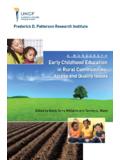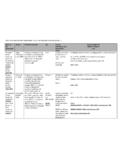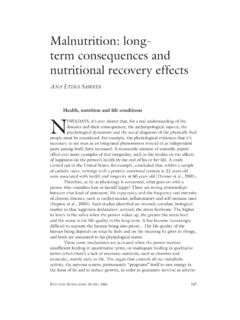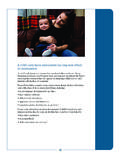Transcription of EARLY CHILDHOOD DEVELOPMENT: A …
1 EARLY CHILDHOOD development : A STATISTICAL SNAPSHOTBuIldIng BeTTer BrAIns And susTAInABle OuTcOmes fOr chIldren UNICEF/NYHQ2009-0231/Estey UNICEF/NYHQ2004-1202/VitaleOVER 200 MILLION CHILDREN under 5 years of age in low- and middle-income countries and increasing numbers in OECD countries and emerging economies will face inequalities and fail to reach their full developmental potential because they grow up with a broad range of risk factors. These include, most notably, poverty; poor health, including malnutrition and infection with HIV; high levels of family and environmental stress and exposure to violence, abuse, neglect and exploitation; and inadequate care and learning These factors also include risks that result from emergencies related to conflict, climate change and global demographic shifts associated with migration and CHILDHOOD development (ECD) is one of the most cost-effective investments a country can make to build human capital and promote sustainable development .
2 Economic analyses from both the developed and developing world point to the same conclusion: Investing in the EARLY years yields some of the highest rates of return to families, societies and countries. The case for investment can be made not only with respect to returns but also to the cost of Science has demonstrated that EARLY CHILDHOOD interventions are important because they help mitigate the impact of adverse EARLY experiences. If not addressed, such experiences can lead to poor health (including obesity, cardiovascular disease and diabetes), low educational attainment, economic dependency, increased violence and crime, and heightened risk of substance abuse and depression all of which add to the costs and burden to Walker, S.
3 P., et al., 'Child development : Risk factors for adverse outcomes in developing countries', The Lancet, vol. 369, 2007, pp. 145 157; Grantham-McGregor, S., et al., 'Developmental Potential in the First 5 Years for Children in Developing Countries', The Lancet, vol. 369, 2007, pp. 60 Britto, P. R., P. L. Engle and C. S. Super, editors, Handbook of EARLY CHILDHOOD development Research and its Impact on Global Policy, Oxford University Press, New York, 2013. EARLYCHILDHOODDEVELOPMENTEDUCATIONPROTEC TIONHEALTH &NUTRITIONSTIMULATION& CAREE arly stimulation and interaction with parents and caregivers jumpstart brain development and promote well-being. Exten-sive research shows that nurturing, stimulating interaction between young children and their parents and caregivers positively and perma-nently strengthens the ability to learn and may even change brain function for life.
4 Adequate nutrition during pregnancy and the first two years of life is necessary for normal brain development , laying the foundation for the development of cognitive, motor and socio-emotional skills throughout CHILDHOOD and adulthood. Appropriate breastfeeding practices can contribute to a child s healthy emotional and cognitive de-velopment. In contrast, lack of adequate nutrition (including iodine) and other related con-sequences such as stunting and low birthweight can compromise children s motor and cogni-tive development . Children with restricted develop-ment of these skills dur-ing EARLY life are at risk for later neuropsy-chological problems, poor school achieve-ment, EARLY school drop-out, low-skilled employment, and poor care of their own children, thus contributing to the in-tergenerational trans-mission of young children from violence and abuse is not only a human rights obligation; it is also the foun-dation from which children can develop to their fullest potential and achieve better health, learning and so-cial development outcomes.
5 Through a combination of ECD and child protection interventions (including direct support to families and strengthen-ing systems to be more responsive and accountable), young chil-dren can be protected from violence and given the op-portunity to develop and grow in a healthy way, from the very first years of in good quality EARLY CHILDHOOD education ser-vices prior to entering school improves learning outcomes for children. It also enhances the efficiency of the school sys-tem by reducing repetition and drop-out and improving achievement, especially among girls and marginalized AND CAREEARLY CHILDHOOD EDUCATION HEALTH AND NUTRITIONSAFETY AND PROTECTIONThe brain requires multiple inputs: It requires stimulation and care to spark neural connections across multiple regions of the brain to increase its capacity and function.
6 It requires access to good quality EARLY CHILDHOOD education programmes that provide children with EARLY cognitive and language skills, build social competency and support emotional development . It requires good health and nutrition at the right time to feed and nourish the architecture of the body, including the brain, during the sensitive periods of development . It requires safety and protection to buffer against stress and allow absorption of nutrients and growth and development of the nervous system - including the brain. All these aspects of the environment must work together to build a better brain. STIMULATION AND CAREP ercentage of children aged 36 to 59 months with whom an adult household member has engaged in four or more activities to promote learning and school readiness in the past three days Percentage of children aged 0 to 59 months who have three or more children s books at homeIn almost all countries or areas, more than half of children are engaged in EARLY learning activities by adults in the household, but less than half have access to three or more books in the homeNotes: Activities to promote learning and school readiness include: reading books to the child; telling stories to the child; singing songs to the child; taking the child outside the home; playing with the child.
7 And spending time with the child naming, counting or drawing things. Data for the Islamic Republic of Iran differ from the standard definition. Data for Lebanon, Morocco and Myanmar refer to children aged 0 to 59 months. Source: UNICEF global databases, 2014, based on Multiple Indicator Cluster Surveys (MICS), Demographic and Health Surveys (DHS) and other nationally representative surveys, : Data for the Islamic Republic of Iran and Morocco differ from the standard definition. Source: UNICEF global databases, 2014, based on MICS, DHS and other nationally representative surveys, and TobagoDemocratic People's Republic of KoreaMontenegroKyrgyzstanSerbiaGeorgiaJa maicaBosnia and HerzegovinaGuyanaThe former Yugoslav Republic of MacedoniaKazakhstanThailandUzbekistanBel izeIran (Islamic Republic of)
8 AlbaniaSyrian Arab RepublicLebanonSurinameMongoliaMoroccoVi et NamTunisiaTajikistanDjiboutiState of PalestineHondurasYemenBhutanGhanaNigeria IraqLao People's Democratic RepublicC te d'IvoireSwazilandCameroonMozambiqueAfgha nistanSierra LeoneTogoGambiaCentral African Republic Democratic Republic of the CongoChadMaliTrinidad and TobagoMontenegroBelarusSerbiaBosnia and HerzegovinaJamaicaGeorgiaThe former Yugoslav Republic of MacedoniaKazakhstanDemocratic People's Republic of KoreaUzbekistanThailandGuyanaKyrgyzstanA lbaniaBelizeSomaliaViet NamCentral African Republic TajikistanAfghanistanSurinameTunisiaChad Iran (Islamic Republic of)Syrian Arab RepublicNigeriaCameroonTogoDemocratic Republic of the CongoBangladeshIraqMyanmarState of PalestineLao People's Democratic RepublicMongoliaLebanonMauritaniaSierra LeoneBhutanC te d'IvoireSwazilandGambiaHondurasMozambiqu eGhanaDjiboutiMoroccoBurundiYemenMaliBur kina Faso010203070408050906010001020307040805 09060100 HEALTH AND NUTRITIONP ercentage of children worldwide put to the breast within one hour of delivery; exclusively breastfed; receiving solid, semi-solid and soft food.
9 And continuing to breastfeed at specified ages Number of newborns unprotected and protected from iodine deficiency disorders (IDDs) as assessed through household consumption of adequately iodized salt, in millionsPercentage of children aged 0 to 59 months who are moderately or severely stunted, by wealth quintilePercentage of newborns weighing less than 2,500 grams at birth, by regionGlobally, less than 40 per cent of infants are exclusively breastfed More than 30 million infants worldwide were at risk of iodine deficiency disorders in 2012 Poorer children are far more likely than their richer counterparts to experience stunted growth Low birthweight is highest in South Asia* Excludes : UNICEF global databases, 2014, based on MICS, DHS and other nationally representative surveys, 2008-2012, with the exception of India (2005-2006).
10 Notes: Estimates are based on a subset of 57 countries covering 60 per cent of the total population worldwide, applied to total births worldwide. Regional estimates represent data covering at least 50 per cent of the regional population. Data coverage was insufficient to calculate regional estimates for Central and Eastern Europe and the Commonwealth of Independent States, Latin America and the Caribbean, and the Middle East and North : UNICEF global databases, 2014, based on MICS, DHS and other nationally representative surveys, : Estimates are based on a subset of 84 countries covering 65 per cent of the births worldwide. Regional estimates represent data covering at least 50 per cent of the regional population. Data coverage was insufficient to calculate regional estimates for Central and Eastern Europe and the Commonwealth of Independent States and the Middle East and North Africa.

















